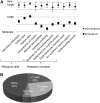Transposing from the laboratory to the classroom to generate authentic research experiences for undergraduates
- PMID: 23172853
- PMCID: PMC3567729
- DOI: 10.1534/genetics.112.147355
Transposing from the laboratory to the classroom to generate authentic research experiences for undergraduates
Abstract
Large lecture classes and standardized laboratory exercises are characteristic of introductory biology courses. Previous research has found that these courses do not adequately convey the process of scientific research and the excitement of discovery. Here we propose a model that provides beginning biology students with an inquiry-based, active learning laboratory experience. The Dynamic Genome course replicates a modern research laboratory focused on eukaryotic transposable elements where beginning undergraduates learn key genetics concepts, experimental design, and molecular biological skills. Here we report on two key features of the course, a didactic module and the capstone original research project. The module is a modified version of a published experiment where students experience how virtual transposable elements from rice (Oryza sativa) are assayed for function in transgenic Arabidopsis thaliana. As part of the module, students analyze the phenotypes and genotypes of transgenic plants to determine the requirements for transposition. After mastering the skills and concepts, students participate in an authentic research project where they use computational analysis and PCR to detect transposable element insertion site polymorphism in a panel of diverse maize strains. As a consequence of their engagement in this course, students report large gains in their ability to understand the nature of research and demonstrate that they can apply that knowledge to independent research projects.
Figures






References
-
- American Association for the Advancement of Science, 2011. Vision and Change in Undergraduate Biology Education: A Call to Action. Washington DC: American Association for the Advancement of Science. Available at: http://visionandchange.org/files/2011/02/Vision-and-Change-low-res.pdf. Accessed: March 16, 2012
Publication types
MeSH terms
Associated data
- Actions
- Actions
- Actions
- Actions
- Actions
- Actions
- Actions
- Actions

